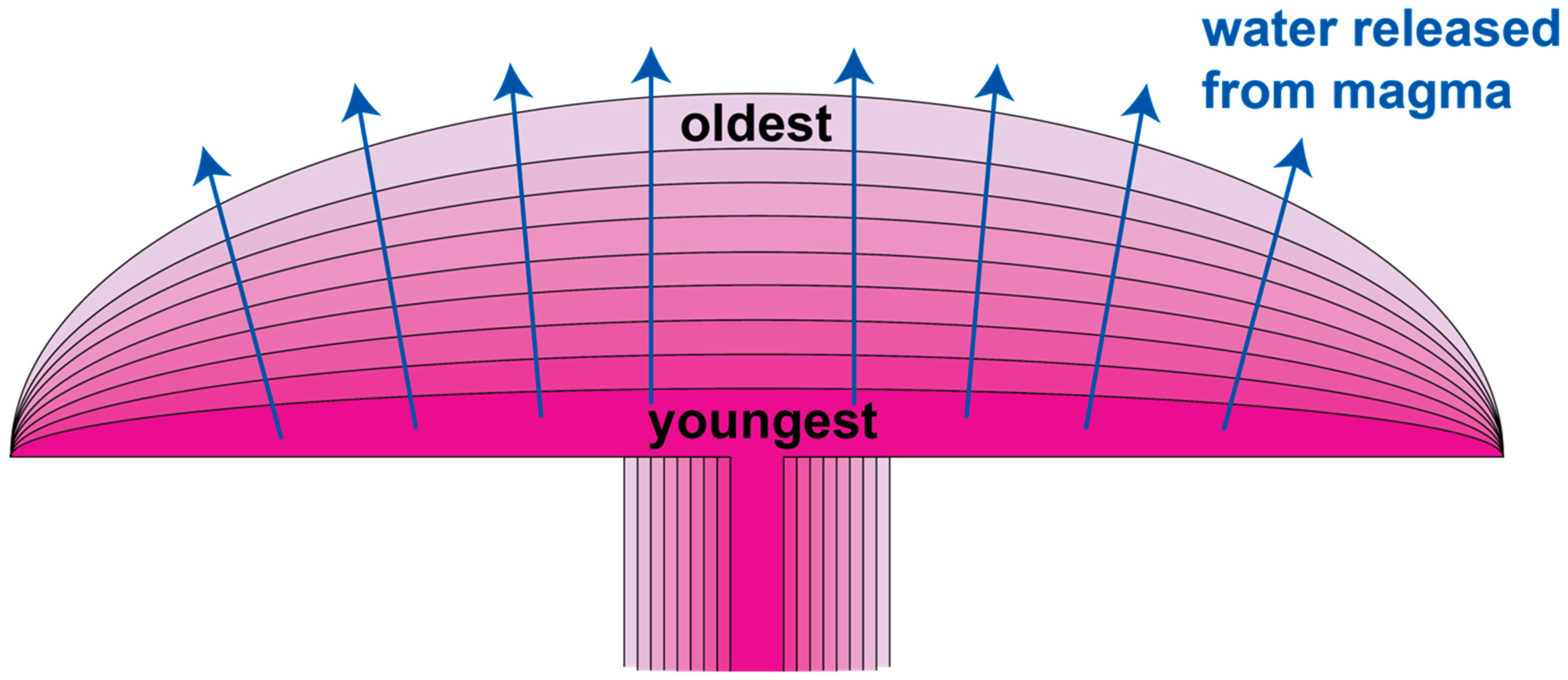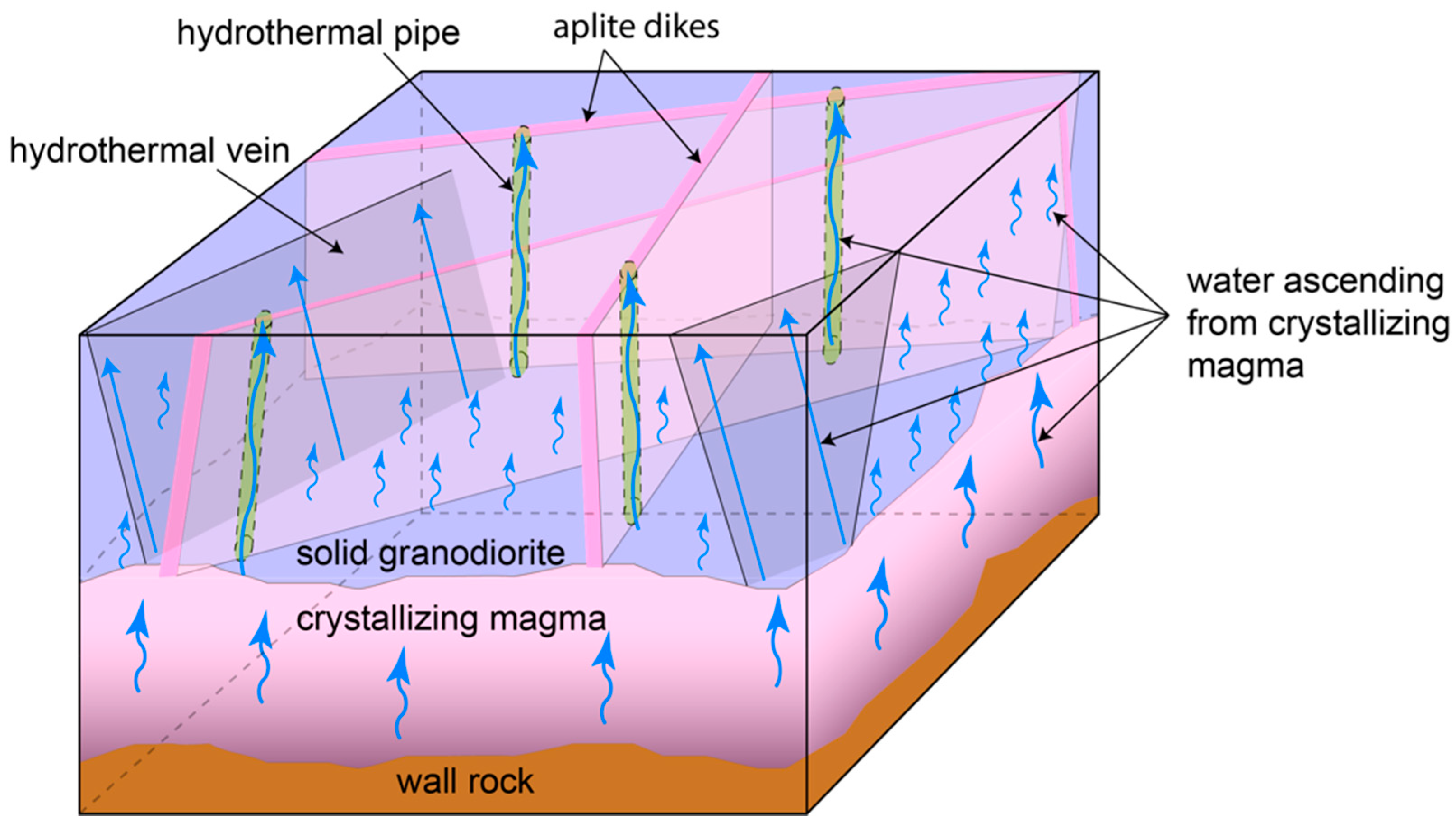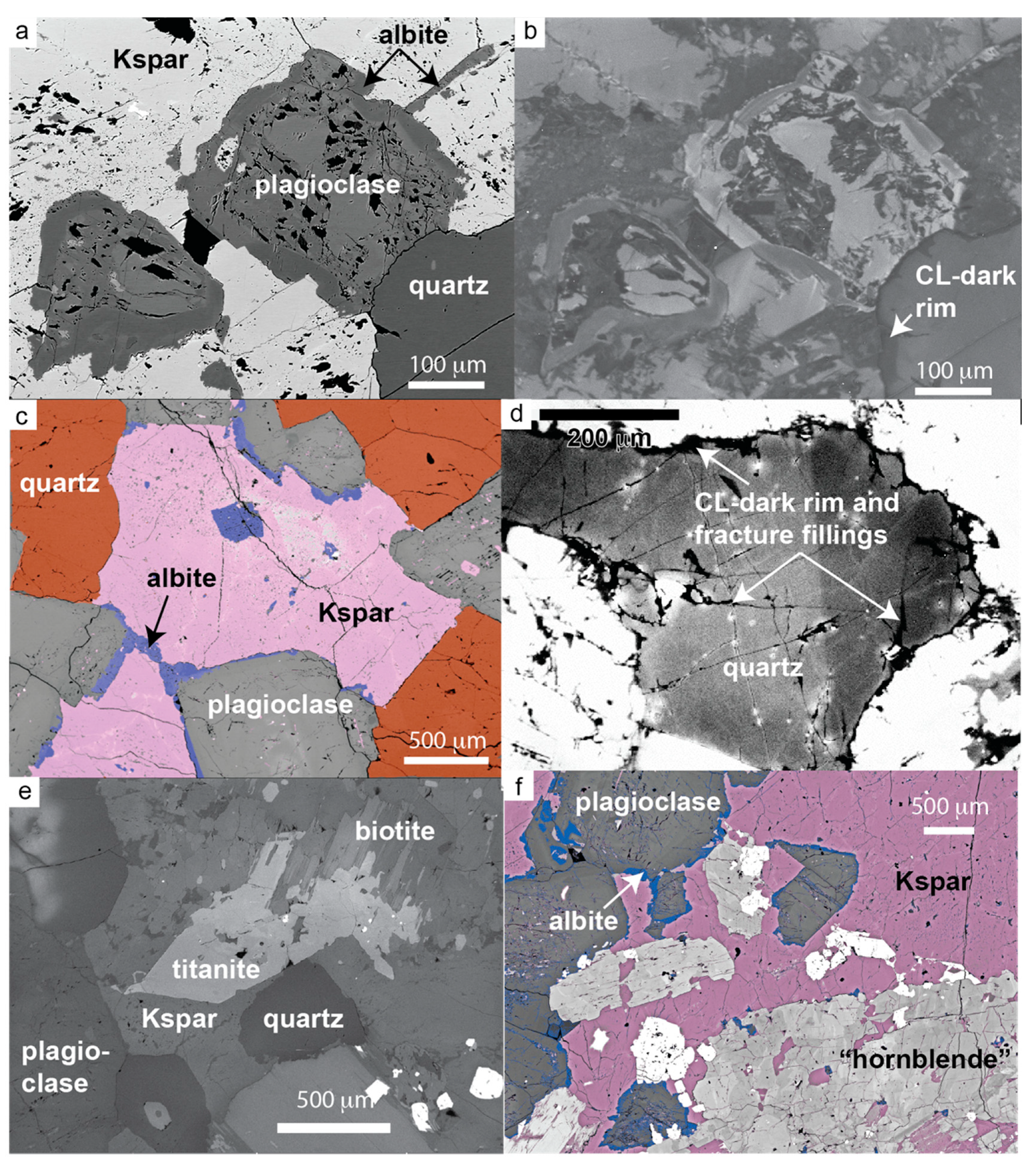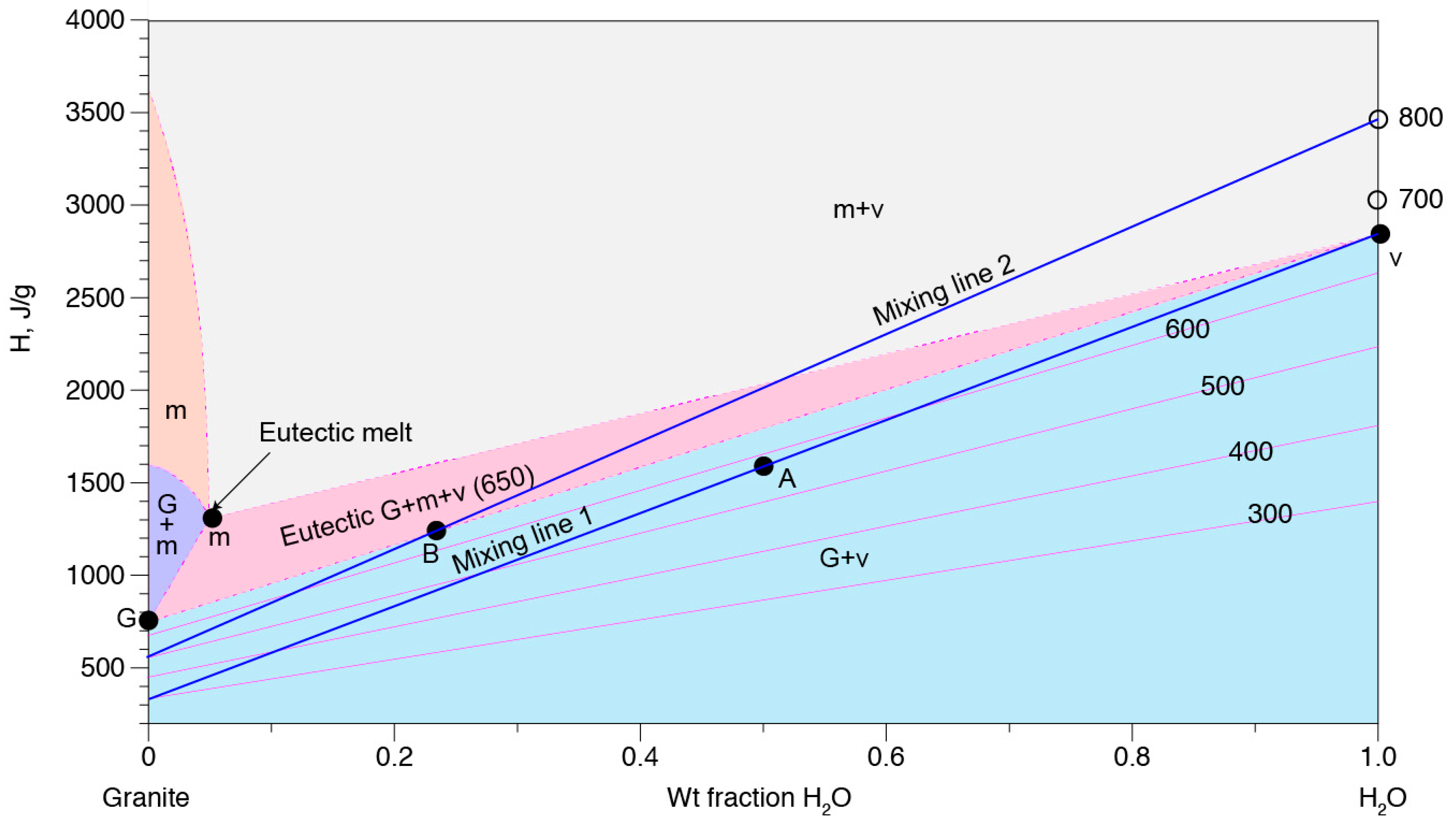The Granite Aqueduct and Autometamorphism of Plutons
Abstract
1. Introduction
2. Amount of Water in Arc Magmas and Arc Rocks
3. Incremental Pluton Growth
4. Downward Growth of Plutons
5. Fluid Transport Paths
6. Thermal Energy Carried by Escaping H2O
7. Other Evidence of Late-Stage Textural Modification
8. Summary
Author Contributions
Funding
Acknowledgments
Conflicts of Interest
References
- Carmichael, I.S.E. The andesite aqueduct: Perspectives on the evolution of intermediate magmatism in west-central (105–99°W) Mexico. Contr. Miner. Petrol. 2002, 143, 641–663. [Google Scholar] [CrossRef]
- Coleman, D.S.; Gray, W.; Glazner, A.F. Rethinking the emplacement and evolution of zoned plutons: Geochronologic evidence for the incremental assembly of the Tuolumne Intrusive Suite, California. Geology 2004, 32, 433–436. [Google Scholar] [CrossRef]
- Michel, J.; Baumgartner, L.; Putlitz, B.; Schaltegger, U.; Ovtcharova, M. Incremental growth of the Patagonian Torres del Paine laccolith over 90 k.y. Geology 2008, 36, 459–462. [Google Scholar] [CrossRef]
- Coleman, D.S.; Bartley, J.M.; Glazner, A.F.; Pardue, M.J. Is chemical zonation in plutonic rocks driven by changes in source magma composition or shallow-crustal differentiation? Geosphere 2012, 8, 1568–1587. [Google Scholar] [CrossRef]
- Bartley, J.M.; Glazner, A.F.; Coleman, D.S. Dike intrusion and deformation during growth of the Half Dome pluton, Yosemite National Park, California. Geosphere 2018, 14, 1–15. [Google Scholar] [CrossRef]
- Sisson, T.W.; Layne, G.D. H2O in basalt and basaltic andesite glass inclusions from four subduction-related volcanoes. Earth Plan. Sci. Lett. 1993, 117, 619–635. [Google Scholar] [CrossRef]
- Wallace, P.J. Volatiles in subduction zones magmas: Concentrations and fluxes based on melt inclusion and volcanic gas data. J. Volc. Geotherm. Res. 2005, 140, 217–240. [Google Scholar] [CrossRef]
- Metrich, N.; Wallace, P.J.; Putirka, K.D.; Frank, J., III. Volatile abundances in basaltic magmas and their degassing paths tracked by melt inclusions. Rev. Miner. Geochem. 2008, 69, 363–402. [Google Scholar] [CrossRef]
- Plank, T.; Kelley, K.A.; Zimmer, M.M.; Hauri, E.H.; Wallace, P.J. Why do mafic arc magmas contain ~4 wt % water on average? Earth Plan. Sci. Lett. 2013, 364, 168–179. [Google Scholar] [CrossRef]
- Grove, T.; Parman, S.; Bowring, S.; Price, R.; Baker, M. The role of an H2O-rich fluid component in the generation of primitive basaltic andesites and andesites from the Mt. Shasta region, N California. Contr. Miner. Petrol. 2002, 143, 641–663. [Google Scholar] [CrossRef]
- Laumonier, M.; Gaillard, F.; Muir, D.; Blundy, J.; Unsworth, M. Giant magmatic water reservoirs at mid-crustal depth inferred from electrical conductivity and growth of the continental crust. Earth Plan. Sci. Lett. 2016, 457, 173–180. [Google Scholar] [CrossRef]
- Matzel, J.E.P.; Bowring, S.A.; Miller, R.B. Time scales of pluton construction at differing crustal levels; examples from the Mount Stuart and Tenpeak Intrusions, north Cascades, Washington. Geol. Soc. Am. Bull. 2006, 118, 1412–1430. [Google Scholar] [CrossRef]
- Stearns, M.A.; Bartley, J.M.; Bowman, J.R.; Forster, C.W.; Beno, C.J.; Riddle, D.D.; Callis, S.J.; Udy, N.D. Simultaneous magmatic and hydrothermal regimes recorded by multiphase U-Pb petrochronology, Alta-Little Cottonwood stocks, Utah, USA. Geosciences 2020, 10, 129. [Google Scholar] [CrossRef]
- Glazner, A.F.; Bartley, J.M.; Coleman, D.S.; Gray, W.; Taylor, R.Z. Are plutons assembled over millions of years by amalgamation of small magma chambers? GSA Today 2004, 14, 4–11. [Google Scholar] [CrossRef]
- Annen, C.; Scaillet, B.; Sparks, R.S.J. Thermal constraints on the emplacement rate of a large intrusive complex: The Manaslu Leucogranite, Nepal Himalaya. J. Petrol. 2006, 47, 71–95. [Google Scholar] [CrossRef]
- Bartley, J.M.; Coleman, D.S.; Glazner, A.F. Incremental emplacement of plutons by magmatic crack-seal. Trans. R. Soc. Edinb. 2006, 97, 383–396. [Google Scholar] [CrossRef]
- Pitcher, W.S.; Berger, A.R. The Geology of Donegal: A Study of Granite Emplacement and Unroofing; Wiley-Interscience: New York, NY, USA, 1972. [Google Scholar]
- Mahan, K.H.; Bartley, J.M.; Coleman, D.S.; Glazner, A.F.; Carl, B.S. Sheeted intrusion of the synkinematic McDoogle pluton, Sierra Nevada, California. Geol. Soc. Am. Bull. 2003, 115, 1570–1582. [Google Scholar] [CrossRef]
- Leuthold, J.; Muentener, O.; Baumgartner, L.P.; Putlitz, B.; Ovtcharova, M.; Schaltegger, U. Time resolved construction of a bimodal laccolith (Torres del Paine, Patagonia). Earth Plan. Sci. Lett. 2012, 325, 85–92. [Google Scholar] [CrossRef]
- Davis, J.W.; Coleman, D.S.; Gracely, J.T.; Gaschnig, R.; Stearns, M. Magma accumulation rates and thermal histories of plutons of the Sierra Nevada batholith, CA. Contr. Miner. Petrol. 2012, 163, 449–465. [Google Scholar] [CrossRef]
- Horsman, E.; Tikoff, B.; Morgan, S. Emplacement-related fabric and multiple sheets in the Maiden Creek sill, Henry Mountains, Utah, USA. J. Struct. Geol. 2005, 27, 1426–1444. [Google Scholar] [CrossRef]
- Farina, F.; Dini, A.; Innocenti, F.; Rocchi, S.; Westerman, D.S. Rapid incremental assembly of the Monte Capanne pluton (Elba Island, Tuscany) by downward stacking of magma sheets. Geol. Soc. Am. Bull. 2010, 122, 1463–1479. [Google Scholar] [CrossRef]
- Gaynor, S.P.; Coleman, D.S.; Rosera, J.M.; Tappa, M.J. Geochronology of a Bouguer gravity low. J. Geophys. Res. 2018, 124, 1–12. [Google Scholar] [CrossRef]
- Cook, S.J.; Bowman, J.R. Contact metamorphism surrounding the Alta stock; thermal constraints and evidence of advective heat transport from calcite + dolomite geothermometry. Am. Min. 1994, 79, 513–525. [Google Scholar]
- Cook, S.J.; Bowman, J.R.; Forster, C.B. Contact metamorphism surrounding the Alta Stock; finite element model simulation of heat- and 18O/16O mass-transport during prograde metamorphism. Am. J. Sci. 1997, 297, 1–55. [Google Scholar] [CrossRef]
- Rogers, J.J.W. Origin of albite in granitic rocks. Am. J. Sci. 1961, 259, 186–193. [Google Scholar] [CrossRef]
- Carmichael, I.S.E. The crystallization of feldspar in volcanic acid liquids. J. Geol. Soc. Lond. 1963, 119, 95–130. [Google Scholar] [CrossRef]
- Phillips, E.R. Myrmekite and albite in some granites of the New England Batholith, New South Wales. J. Geol. Soc. Austr. 1964, 11, 49–60. [Google Scholar] [CrossRef]
- O’Neil, J.R.; Taylor, H.P.J. The oxygen isotope and cation exchange. Am. Min. 1967, 52, 1414–1437. [Google Scholar]
- Putnis, A.; John, T. Replacement processes in the Earth’s Crust. Elements 2010, 6, 159–164. [Google Scholar] [CrossRef]
- Glazner, A.F. K-feldspar and cooties; or why K-feldspar likes to grow into big crystals. In Proceedings of the GSA Annual Meeting, Phoenix, AZ, USA, 22–25 September 2019. [Google Scholar]
- Valley, J.W.; Graham, C.M. Ion microprobe analysis of oxygen isotope ratios in quartz from Skye granite; healed micro-cracks, fluid flow, and hydrothermal exchange. Contr. Miner. Petrol. 1996, 124, 225–234. [Google Scholar] [CrossRef]
- Glazner, A.F.; Bartley, J.M.; Coleman, D.S.; Lindgren, K. Aplite diking and infiltration: A differentiation mechanism restricted to plutonic rocks. Cont. Min. Petrol. 2020, 175, 37. [Google Scholar] [CrossRef]
- Johnson, B.W.; Bowman, J.R.; Nash, B.P.; Valley, J.W.; Bartley, J.M. Oxygen isotope, TitaniQ, and cathodoluminescence analyses of the Alta stock, UT: Preliminary insights into pluton assembly. Geol. Soc. Am. Abstr. 2009, 41, 43. [Google Scholar]
- Challener, S.C.; Glazner, A.F. Igneous or metamorphic? Hornblende phenocrysts as greenschist facies reaction cells in the Half Dome Granodiorite, California. Am. Min. 2017, 102, 436–444. [Google Scholar] [CrossRef]
- Burnham, C.W.; Holloway, J.R.; Davis, N.F. Thermodynamic Properties of Water to 1000 °C and 10,000 Bars; Geological Society of America: Boulder, CO, USA, 1969. [Google Scholar]
- Robie, R.A.; Hemingway, B.S.; Fisher, J. Thermodynamic properties of Minerals and Related Substances at 298.15 K and 1 Bar (105 Pascals) Pressure and at Higher Temperatures. 1978. Available online: https://pubs.er.usgs.gov/publication/b2131 (accessed on 10 April 2020).
- Ussler, W., III; Glazner, A.F. Graphical analysis of enthalpy-composition relationships in mixed magmas. J. Volc. Geotherm. Res. 1992, 51, 23–40. [Google Scholar] [CrossRef]
- Johannes, W.; Holtz, F. Petrogenesis and Experimental Petrology of Granitic Rocks; Springer: New York, NY, USA, 1996. [Google Scholar]
- Glazner, A.F. The ascent of water-rich magma and decompression heating: A thermodynamic analysis. Am. Min. 2019, 104, 890–896. [Google Scholar] [CrossRef]
- Ackerson, M.R.; Mysen, B.O.; Tailby, N.D.; Watson, E.B. Low-temperature crystallization of granites and the implications for crystal magmatism. Nature 2018, 559, 94–97. [Google Scholar] [CrossRef] [PubMed]
- Higgins, M.D. Origin of megacrysts in granitoids by textural coarsening; a crystal size distribution (CSD) study of microcline in the Cathedral Peak Granodiorite, Sierra Nevada, California. Geol. Soc. Spec. Pubs. 1999, 168, 207–219. [Google Scholar] [CrossRef]
- Johnson, B.R.; Glazner, A.F. Formation of K-feldspar megacrysts in granodioritic plutons by thermal cycling and late-stage textural coarsening. Contr. Miner. Petrol. 2010, 159, 599–619. [Google Scholar] [CrossRef]
- Glazner, A.F.; Johnson, B.R. Late crystallization of K-feldspar and the paradox of megacrystic granites. Contr. Min. Petrol. 2013, 166, 777–799. [Google Scholar] [CrossRef]
- Cabane, H.; Laporte, D.; Provost, A. Experimental investigation of the kinetics of Ostwald ripening of quartz in silicic melts. Contrib. Miner. Petrol. 2001, 142, 361–373. [Google Scholar] [CrossRef]
- Cabane, H.; Laporte, D.; Provost, A. An experimental study of Ostwald ripening of olivine and plagioclase in silicate melts; implications for the growth and size of crystals in magmas. Contrib. Miner. Petrol. 2005, 150, 37–53. [Google Scholar] [CrossRef]
- Holness, M.B.; Vernon, R.H. The influence of interfacial energies on igneous microstructures. In Layered Intrusions; Charlier, B., Namur, O., Latypov, R., Tegner, C., Eds.; Springer: Dordrecht, The Netherlands, 2015; pp. 183–227. [Google Scholar]
- Gualda, G.A.R. On the origin of alkali feldspar megacrysts in granitoids: The case against textural coarsening. Contr. Miner. Petrol. 2019, 174, 88. [Google Scholar] [CrossRef]
- Mills, R.D.; Glazner, A.F. Experimental study on the effects of temperature cycling on coarsening of plagioclase and olivine in an alkali basalt. Contrib. Miner. Petrol. 2013, 166, 97–111. [Google Scholar] [CrossRef]
- Erdmann, M.; Koepke, J. Experimental temperature cycling as a powerful tool to enlarge melt pools and crystals at magma storage conditions. Am. Miner. 2016, 101, 960–969. [Google Scholar] [CrossRef]
- Donhowe, D.P.; Hartel, R.W. Recrystallization of ice cream during controlled accelerated storage. Int. Dairy J. 1996, 6, 1191–1208. [Google Scholar] [CrossRef]
- Mills, R.D.; Ratner, J.J.; Glazner, A.F.; Mills, R.D. Experimental evidence for crystal coarsening and fabric development during temperature cycling. Geology 2011, 39, 1139–1142. [Google Scholar] [CrossRef]






© 2020 by the authors. Licensee MDPI, Basel, Switzerland. This article is an open access article distributed under the terms and conditions of the Creative Commons Attribution (CC BY) license (http://creativecommons.org/licenses/by/4.0/).
Share and Cite
Bartley, J.M.; Glazner, A.F.; Stearns, M.A.; Coleman, D.S. The Granite Aqueduct and Autometamorphism of Plutons. Geosciences 2020, 10, 136. https://doi.org/10.3390/geosciences10040136
Bartley JM, Glazner AF, Stearns MA, Coleman DS. The Granite Aqueduct and Autometamorphism of Plutons. Geosciences. 2020; 10(4):136. https://doi.org/10.3390/geosciences10040136
Chicago/Turabian StyleBartley, John M., Allen F. Glazner, Michael A. Stearns, and Drew S. Coleman. 2020. "The Granite Aqueduct and Autometamorphism of Plutons" Geosciences 10, no. 4: 136. https://doi.org/10.3390/geosciences10040136
APA StyleBartley, J. M., Glazner, A. F., Stearns, M. A., & Coleman, D. S. (2020). The Granite Aqueduct and Autometamorphism of Plutons. Geosciences, 10(4), 136. https://doi.org/10.3390/geosciences10040136




